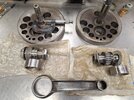This is a timely thread for me, I have been tasked by a Section Member to carry out some machining work on a Comet engine to take a 92mm Terry Prince top end.
He has also handed me a pair of standard flywheels, conrod and two big end assemblies. The BE's are both 40x48, one with 1.003" shafts, one with 1.125" shafts, both with 7/8" threads. The 1.0" shaft BE falls into the flywheels so the 1 1/8" is the only choice.
The conrod will need the big end honing round, fortuitously, one of the big end bearing rings is over size, but the small end bore has a ridge indicating that it has had a loose bush.
Even if the flywheels and conrod were 100% within standard Vincent tolerances, are they capable of withstanding the extra power generated by a TP top end with MK II cam when being used for spirited road riding?
I would value the opinions of the learned here, please.
He has also handed me a pair of standard flywheels, conrod and two big end assemblies. The BE's are both 40x48, one with 1.003" shafts, one with 1.125" shafts, both with 7/8" threads. The 1.0" shaft BE falls into the flywheels so the 1 1/8" is the only choice.
The conrod will need the big end honing round, fortuitously, one of the big end bearing rings is over size, but the small end bore has a ridge indicating that it has had a loose bush.
Even if the flywheels and conrod were 100% within standard Vincent tolerances, are they capable of withstanding the extra power generated by a TP top end with MK II cam when being used for spirited road riding?
I would value the opinions of the learned here, please.

